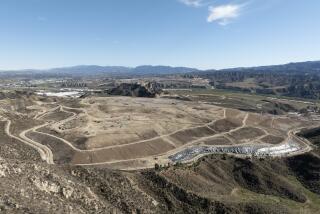To build his ‘big, beautiful park,’ this landowner is filling a canyon with debris. Critics say he built a dump
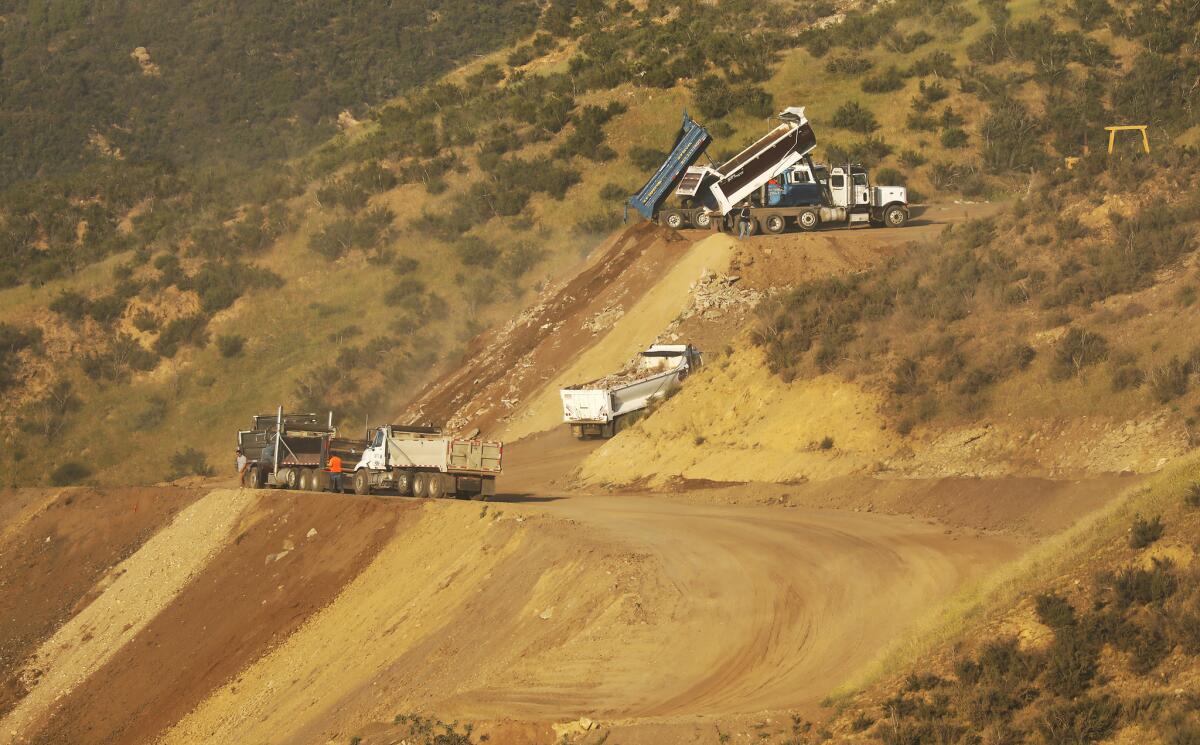
- Share via
In the rugged hills above Chatsworth, as many as 100 trucks a day pour tons of construction debris into a steep ravine. Earthmovers level the mounds of broken concrete, rebar and bricks, gradually filling in the canyon.
For Wayne Fishback and his Alpha, Bravo, Coca Waste Management Corp., it’s a business: Truckers pay $150 per load. But, he argues, it’s also a glimpse at a sustainable future.
The piles of inert construction waste are not a dump, Fishback said, but instead a way to use recycled materials to flatten otherwise undevelopable terrain. Eventually, he vows to build atop the 250 acres what he calls Liberty Ranch, constructing not just a destination for hikers and horse lovers but — at no cost to the county — a solution to the region’s rising homeless population.
“It’s going to be a big, beautiful park with cabins, horses and zip lines, too,” Fishback, a lean man with thinning hair and a tidy white beard, said with a smile.
But neighbors and regulators fear it could be an environmental and engineering calamity.
It’s going to be a big, beautiful park with cabins, horses and zip lines, too.
— Wayne Fishback, landowner
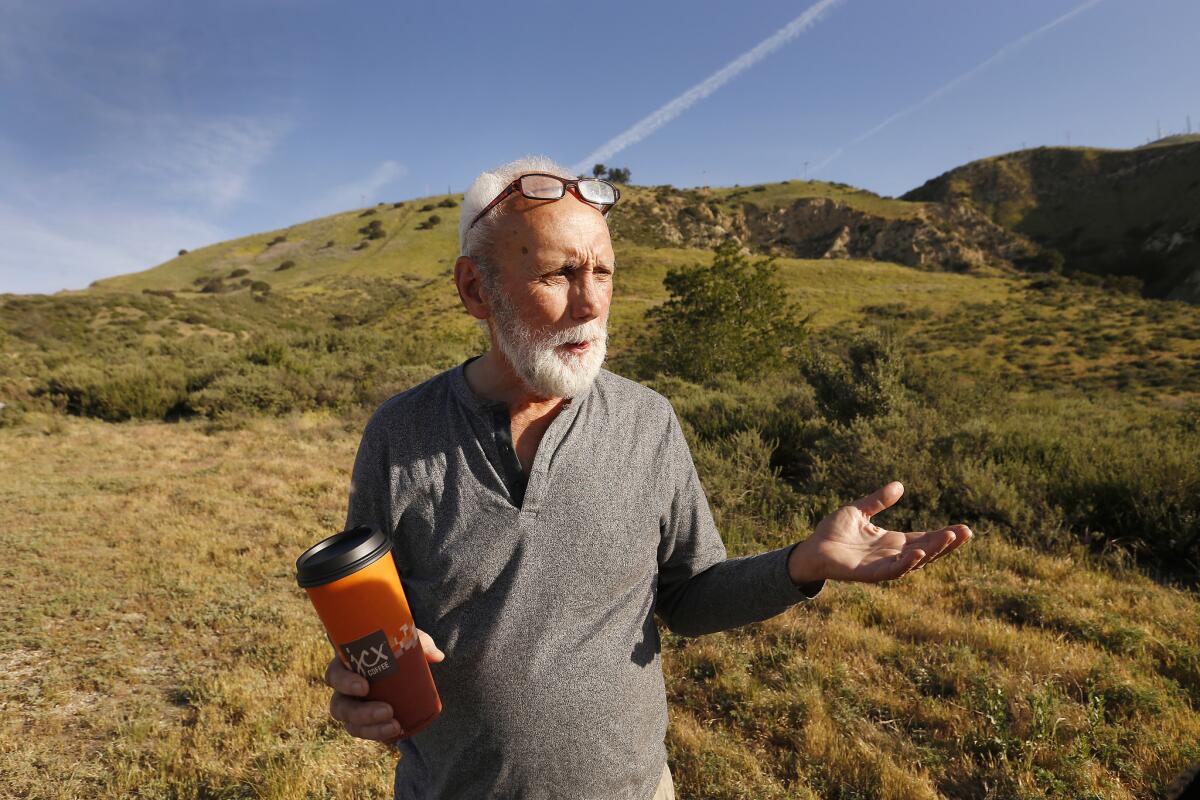
Local residents and county officials have for years complained that Fishback is operating a dump without required permits.
They worry about the volume of trucks along the twisty 3.2-mile Browns Canyon Road, which leads to Michael D. Antonovich Regional Park as well as Fishback’s property. And they fret about the hazard posed by the landfill, which occupies one of the last patches of prime wildlife habitat in the north San Fernando Valley’s Santa Susana Mountains.
A Los Angeles County Superior Court judge ruled in their favor in 2015, issuing a preliminary injunction barring Fishback from receiving additional construction debris without conditional use and grading permits. At a hearing scheduled for Friday, county attorneys will argue that Fishback should be penalized for continuing to operate the facility despite the injunction.
“For too long, our residents have had to deal with hundreds of trucks speeding through their neighborhoods dumping tons of broken concrete and other unknown material on environmentally sensitive land,” said Los Angeles County Supervisor Kathryn Barger, whose district includes the property. “We need to put an end to the devastating impact this has had on the environment and our communities.”
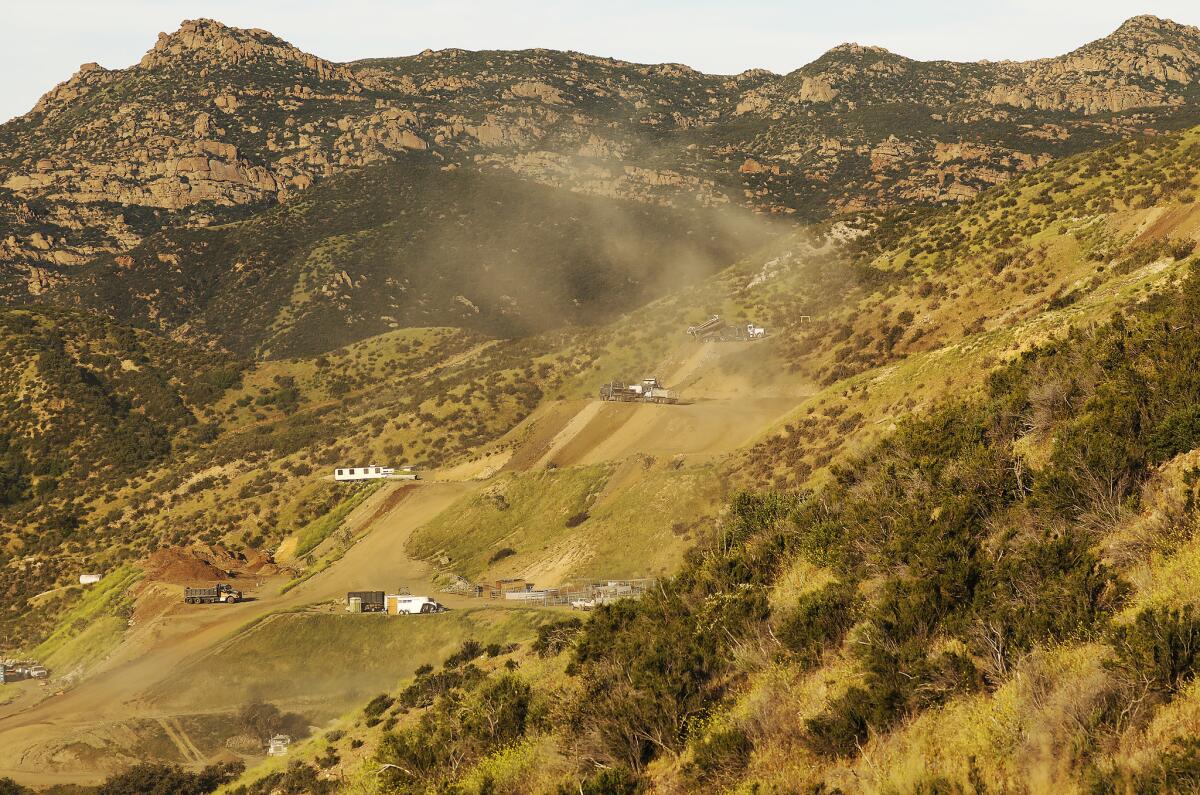
It’s not the first time Fishback has presided over a controversial landfill operation. In 2015, a Ventura County Superior Court judge ordered Fishback, 73, and his wife, Carol, 68, to pay the county $22 million for refusing to clean up what officials said was one of the largest illegal dumps in that county’s history.
In a stern ruling, Judge Kent Kellegrew found “that no reasonable person would honestly believe they could grade and fill 42 acres with upwards of 8,000 truckloads of debris, disrupt neighbors, endanger residents, and destroy the environment without obtaining a permit from any government entity.”
He pointed out that a county examination of only 1% of the deposited fill — which Fishback likes to say was “pure as Ivory soap” — revealed a variety of solid waste, as well as an electrical panel, electrical conduit, PVC pipes and plastic bags and sheeting.
Kellegrew likened the site to a “loaded gun” pointed at Simi Valley. “It could fail,” he said, “and a debris flow of tens of thousands of cubic yards of material could come sliding down the canyon at speeds of 20 mph or more. This debris flow would cause property damage, and could kill residents below.”
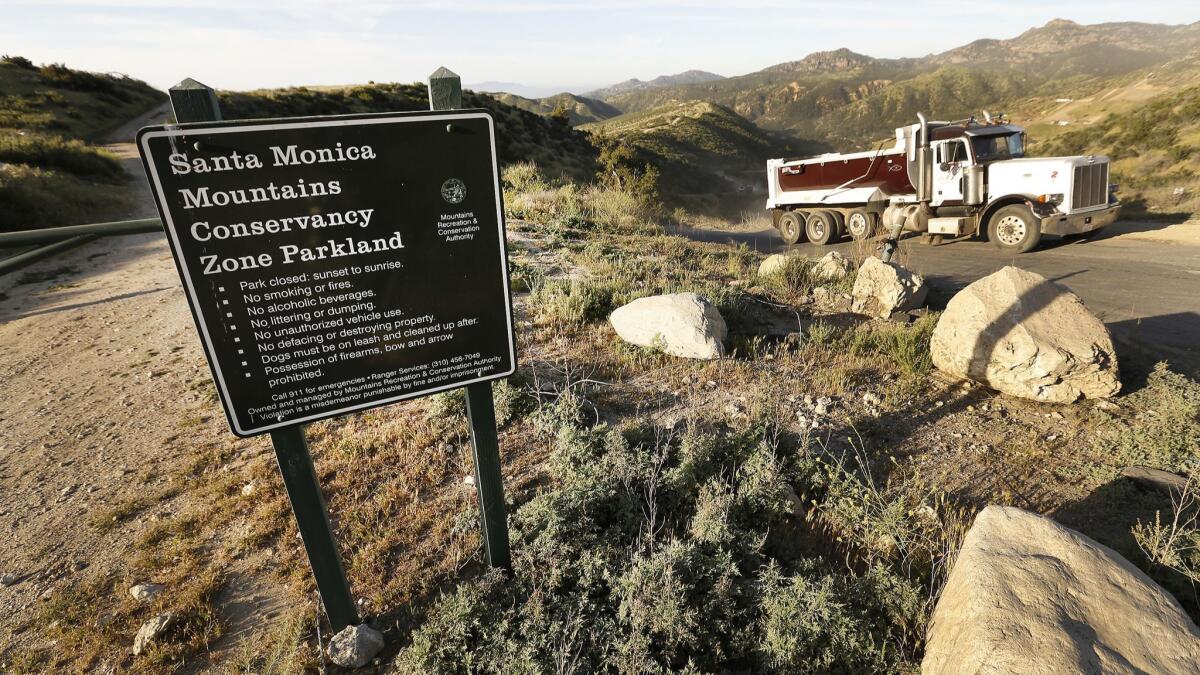
Fishback, who represented himself in the Ventura case, left no doubt about his unhappiness with the ruling. “That judge just got it wrong,” he said. “I’m planning to bring a $200-million lawsuit against Ventura County and Los Angeles County in federal court for obstructing my business.”
His property in Ventura County is zoned for open space and his Los Angeles County land is zoned for heavy agriculture, according to court documents. Despite the judges’ rulings that permits are required for altering the lands, Fishback insists, “I don’t need a permit on land zoned for heavy agriculture. The law is on my side. That doesn’t mean the courts are.”
Deborah Fox, an attorney representing the state of California and Los Angeles County in the case, disagrees. “Wayne Fishback is running an illegal dump,” she said, “and the existing injunction is simply insufficient to prevent these illegal activities.”
County attorneys plan to ask the court to modify the injunction — giving it teeth.
They have filed a motion asking the court to require that Fishback pay for, erect and maintain signs advising truck drivers of the ban on dumping, and warning that scofflaws may be found in contempt of court. They are asking the court to fine Fishback $500 a truck or $20,000 a day for violations of the injunction, whichever is greater. In addition, they want the court to appoint a monitor, at Fishback’s expense, who could assess fines if trucks enter the property without authorization, record unpermitted grading and turn trucks away before they make the steep trek up Browns Canyon Road.
The motion also requests that Fishback be required to apply for a conditional use permit and a regular grading permit so that the county can advise him of the steps needed to stabilize the hillsides to prevent slides.
Residents opposed to Fishback’s activities declined to comment for fear of retaliation.
But Charles Lee, a developer who owns land adjacent to Fishback’s operation and is a named co-defendant in the Chatsworth case, said, “Wayne is a flawed hero, and a genius.”
“I like that he believes he is right — and stands up to ‘the Man,’ ” Lee said, referring to regulatory authorities. “Does he go overboard on occasion? Yes.”
Other supporters include Marcela Oliva, a professor of architecture at Los Angeles Trade-Technical College, and John Bollinger, a part-time instructor of construction at Cal State Long Beach. Both regard Fishback’s project as an emblem of what can be accomplished by recycling demolition debris instead of simply hauling it straight to a landfill for burial.
“Even if he fails, he will be a pioneer in leading the way toward reusing inert debris,” said Bollinger, who does consulting work for Fishback.
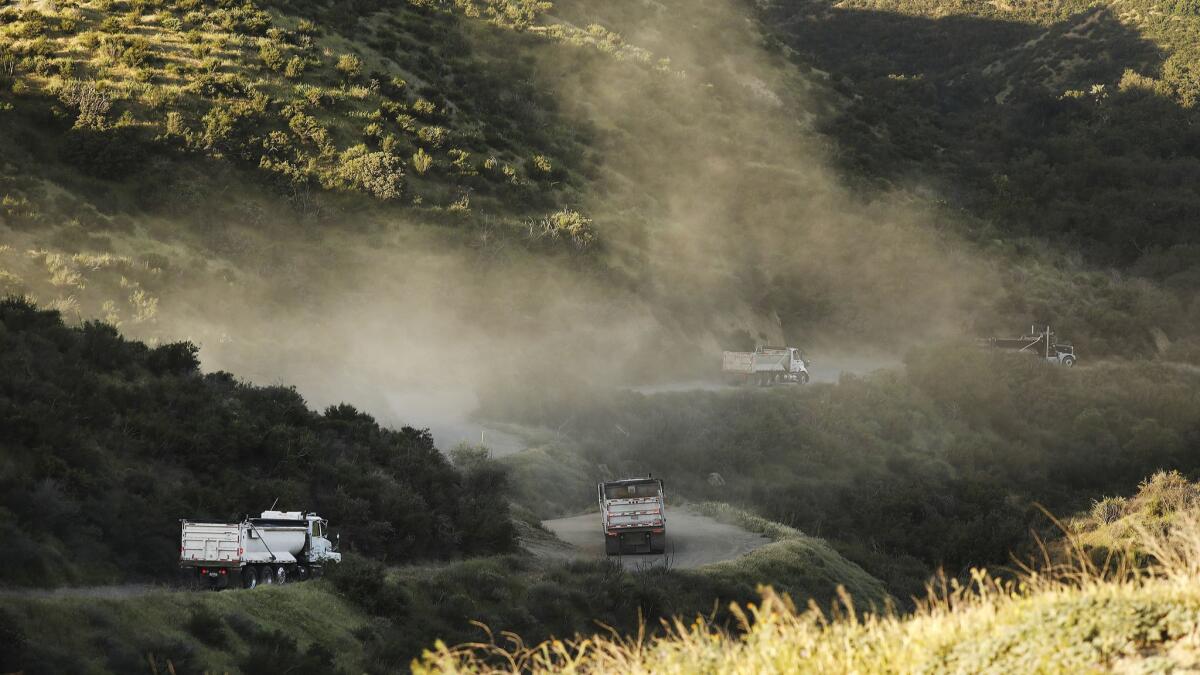
Recycling concrete has become a relatively common use for construction rubble. Arcadia Reclamation Inc., which operates fully permitted solid waste facilities in Irwindale, announced plans this year to have a 1-million-square-foot warehouse distribution and logistics center built atop a landfill that has reached capacity.
Arcadia Reclamation charges $250 per truckload, about $100 more than Fishback, company officials said.
The son of a real estate investor, Fishback was raised on a farm in Illinois. In the 1980s, he was a licensed architect in several states including Illinois, where he was senior partner for design at Chicago-based Schmidt, Garden & Erickson.
Those licenses expired long ago, said Fishback, who considers himself an expert in interpreting laws that relate to architecture, engineering and recycling construction debris.
In 2001, the Fishbacks began buying property in the county line-straddling canyon lands of the Santa Susana Mountains. Tension has been rising in those areas ever since.
A year ago, park rangers acting on behalf of the Santa Monica Mountains Conservancy tried to block truck drivers from accessing Fishback’s work site via Browns Canyon Road. In a lawsuit, Fishback accused the opponents of “wrongfully, purposefully, and intentionally” interfering with his business by blocking access on what he contends is an easement to his property from the 118 Freeway.
In a response, Jeff Maloney, chief counsel for the conservancy, questioned the validity of that easement and argued that Fishback is “brazenly violating and defying” the injunction “forbidding the very activity — operation of an illegal landfill using defendant’s property — that he petitions this court to allow.”
That lawsuit remains unresolved.
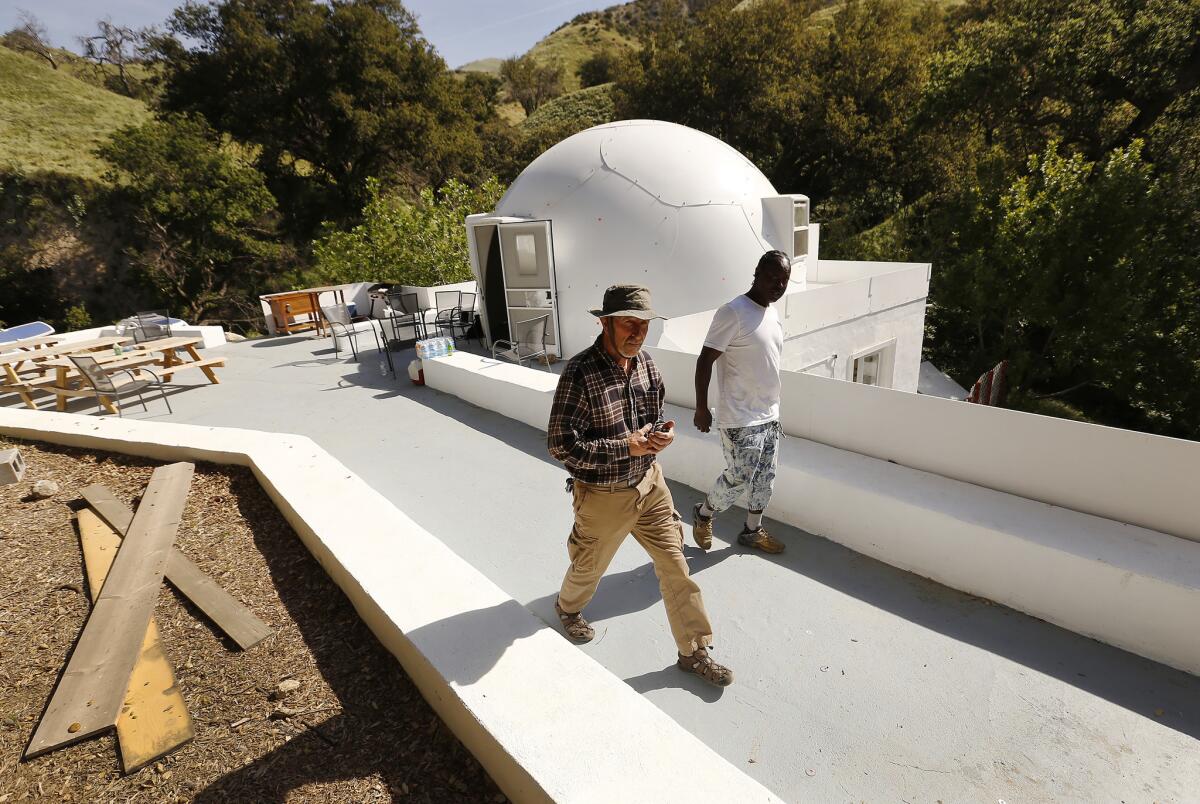
Fishback’s defense hinges on the idea that the infill is improving his property to allow future development. One part of his plan that has caught opponents by surprise is his promise to construct a “village for homeless people” on site.
Incongruous? Perhaps. Believable? You bet, says Fishback, who about six months ago established relations with activists in low-income communities south of downtown Los Angeles.
As a guest on “Uncle Bobby’s Country Corner,” a podcast focusing on African American issues, Fishback talked about the benefits of “rebuilding slums and ghettos” with recycled concrete, and about his association with Amer-I-Can, a nonprofit created by former professional football player Jim Brown to help troubled individuals improve their lives.
Rock Johnson, national chief of staff of Amer-I-Can and a former Compton Crips gang member, is a believer.
“I know a lot of people with loads of money who love what we do but never donate to our cause — Wayne Fishback is not one of them,” Johnson said. “This old, blond white guy already has current and former gang members at his ranch learning life skills by removing brush, maintaining trails and recycling trash.
“If he’s forced to shut down that ranch,” Johnson said, “I’ll always appreciate his giving these guys an opportunity at no cost and no red tape.”
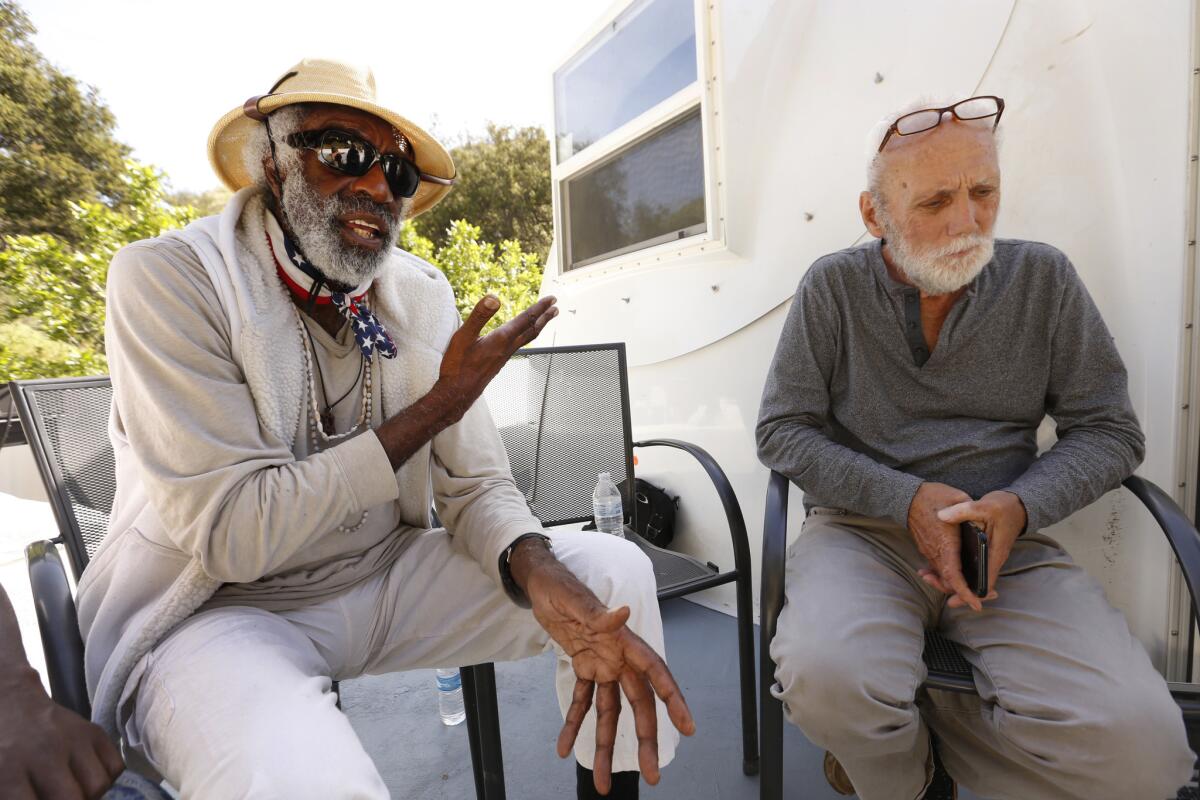
Then there’s Ted Hayes, 67, a lean and lanky Los Angeles activist for the homeless whose most tangible success was Dome Village: 18 portable, fiberglass domed housing units built in 1993 on a parking lot next to a freeway onramp. Designed to alleviate homelessness in downtown Los Angeles, the project ended 15 years later, a victim of rising property values and rent increases.
Relaxing on lawn chairs shaded by oak trees near where dump trucks were unloading, Fishback and Hayes said they hope to reboot the utopian concept on Liberty Ranch.
“We have areas right now sufficient to house 30 domes,” said Fishback, who is considering rent of $150 a month for each dome.
Hayes, wearing a pith helmet and an American flag handkerchief tied around his neck, thanked Fishback for offering “another opportunity for me, a homeless activist, to break the cycle of homelessness.”
County attorneys would not go that far.
“Homeless shelters are not permitted on land zoned for heavy agriculture,” Fox said. “Mr. Fishback would have to obtain a zone change and discretionary permit approval in order to proceed.”
Twitter: @LouisSahagun
More to Read
Sign up for Essential California
The most important California stories and recommendations in your inbox every morning.
You may occasionally receive promotional content from the Los Angeles Times.


